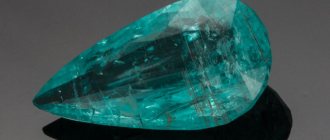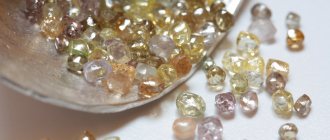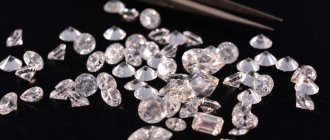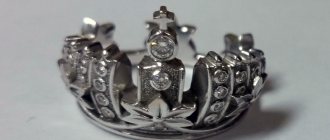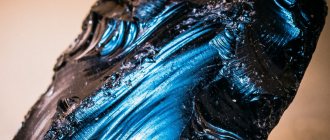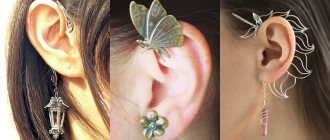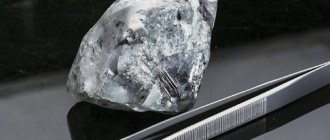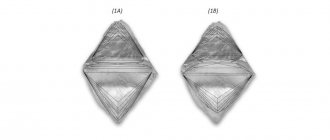Author: stabskapitan
31 January 2021 21:34
Tags: interesting to know history facts
8144
15
"Cumlinan", "Cullinan" (or "Star of Africa") is the largest diamond in the world. Its weight was 3106.75 carats (621.35 grams), dimensions 100x65x50 mm.
0
See all photos in the gallery
copy diamond
The famous diamond was found by accident. Fortune fell on the Premier mine in the Transvaal, near the city of Pretoria in what is now South Africa. On January 25, 1905, mine manager Frederick Wells made his nightly inspection of the mine. When he descended to a depth of five meters, in the reflections of the setting sun in the wall above his head, he noticed a flash of light. At first, Frederick thought that one of the miners was joking and stuck a piece of glass into the wall of the mine. However, he still came closer and, using a pocketknife, extracted from the rock a crystal about ten centimeters long, six centimeters wide and seven centimeters high.
0
Experts soon discovered an interesting feature of the shape and structure of its crystal. It turned out that Cullinan was part of a much larger stone. Once upon a time, nature split a huge diamond, and most of it remains unfound. The discovery of the world's largest diamond became a real sensation. It not only aroused public interest, but also gave a powerful impetus to the development of the diamond mining industry. Particularly exciting was the fact that part of the diamond from which Cullinan had broken off still remained in the ground. Mine manager Frederick Wells received £3,500 for the find. The diamond itself was purchased from Sir Thomas Cullinan by the Transvaal government for £150,000. On the initiative of the Prime Minister of the Transvaal, General Louis Botha, it was decided to give the diamond to the English King Edward VII in honor of his 66th birthday. Thus, the country intended to express gratitude to him for recognizing the constitution of the Transvaal, the territory of which became part of the British Empire in 1902 as a result of the Boer War. The decision to give Cullinan to the King of England was made by vote. Oddly enough, the majority of the Boers supported this decision, while the English part of the country's population, on the contrary, was against it. The final word remained with the king himself - whether to accept the gift or not. A significant role in Edward VII's decision to accept the stone was played by the future Prime Minister of England Winston Churchill, who actively advocated showing mercy to the Boers defeated in the war.
0
In 1905, Cullinan had to be transported to England for ceremonial presentation to the king. Unprecedented security measures were taken to ensure the safety of the cargo. Several detectives from Scotland Yard arrived especially from London. In addition, additional security guards were hired. The diamond was loaded with honors onto a ship bound for Great Britain. However, upon arrival at the place, the priceless stone was not there. The fact is that the noisy and public dispatch was just a distraction. Instead of the diamond, a copy of it was brought to the ship under guard. It was decided to send the real Cullinan in a different way. As a result, he arrived safely in England... via an ordinary registered postal parcel. One can only envy the steely nerves of the British of that time, as well as their absolute faith in Royal Mail - the Royal Mail of England. In November 1907, the world's largest diamond was presented to King Edward VII of Great Britain on his 66th birthday. At a gala reception in the presence of guests and royalty from other countries, the Secretary of State, on behalf of the monarch, announced that he was receiving it “for himself and his successors.” There was also a guarantee that “this great and unique diamond will be kept and protected among the rest of the historical stones that make up the heritage of the crown.”
0
With the approval of the king, the cutting of the diamond was entrusted to the famous Amsterdam company IJ Asscher & Co. The company of hereditary cutters, the Aschers, became famous for being the first to patent the original “Asscher” cut in 1902, which is now classified as a classic cut. In addition, the Dutch company in 1903 successfully cut the Excelsior diamond, the largest in the world before the Cullinan. Josef Ascher studied the unique diamond for several months before making a barely noticeable scratch on it. After this, in the presence of several famous jewelers, in the midst of solemn silence, Asher put a chisel to a scratch on the diamond, hit it with a hammer and lost consciousness. But the calculation turned out to be correct. Having regained consciousness, Asher repeated this operation several more times on the fragments of the Cullinan diamond that had arisen from the first blow. As a result of cutting and polishing, nine large diamonds of exceptional quality and 96 small ones were born. The largest of the nine diamonds was called Cullinan I, the smallest, respectively, Cullinan IX. Mentions of the first two of these nine famous diamonds can be found in our specially prepared Table of the Largest Diamonds in the World.
0
0
0
Cullinan I
The Cullinan I or "Great Star of Africa" is the largest of all the diamonds produced by cutting the Cullinan diamond. It weighs 530.20 carats and is pear-shaped with 76 facets. By order of King Edward VII, the diamond was mounted in the top of the royal scepter, which is currently on display in the Tower of London.
0
The fate of the stone
This is what Cullinan looked like before processing
In 1907, the stone, brought on a warship under heavy security, was presented as a birthday gift to King Edward VII of Great Britain and Ireland. This is how the annexed colony showed its respect and loyalty.
In 1908, the diamond was taken to Amsterdam, to the greatest master Joseph Ascher for jewelry processing. It was a very responsible and difficult task - to divide the stone in such a way as not to spoil its beauty.
The result was two large stones and three small fragments. From large parts, after processing, they created the Great Star of Africa - a crystal with 75 facets, and the Second Star of Africa with 66 facets.
The Second Star adorned the sovereign scepter, and the Big Star adorned the imperial crown. Small crystals were used to create diamonds that adorned the Queen of England’s brooch and a necklace with emeralds.
The total number of precious stones was 105 pieces. A collection of famous jewelry can be viewed at the annual exhibition at Buckingham Palace.
Cullinan II
The Cullinan II or "Little Star of Africa", the second largest of the Cullinan diamonds, weighs 317.4 carats and is cushion cut. It ranks fifth among the largest diamonds in the world. Cullinan II is set on the rim of the Crown of the British Empire, along with such famous stones as the St Edward's sapphire, the Stuart sapphire and the Black Prince ruby. The crown, along with other royal treasures, is on display in the Tower of London.
0
An unexpected find
Diamond "Cullinan" - "Star of Africa".
Before the discovery of the Cullinan, the largest diamond was considered to be the Excelsior, also found in South Africa in 1893. Its weight was about 972 carats. However, he did not have to excel for long. One evening, January 25, 1905, the manager of the Premier mine in the Transvaal, Frederick Wells, made an evening inspection of his farm. Having descended to a depth of five meters underground, in the reflections of the setting sun, he noticed a flash of light in the wall of the mine above his head. Frederick thought that one of the miners was joking and stuck a piece of glass there. However, Wells got closer to the sparkling “glass” and, using a pocketknife, removed it from the wall. It was a crystal about 10 centimeters long, six centimeters wide and seven centimeters high. Realizing that there was a huge diamond in front of him, Frederick could only say:
- God, Mr. Cullinan will be pleased with this!
When Wells showed the find in the office, they also doubted that it was a diamond and advised them to simply throw the stone away. Nevertheless, he was nevertheless examined and weighed. Doubts were dispelled: a diamond was found, and such as had never been seen before. They decided to urgently notify the president of the diamond mining company at the Premier mine, Thomas Cullinan, about the discovery. He was just having dinner with friends. As the meal drew to a close and the ice cream was served, a messenger came in and handed the owner an urgent telegram. The news of the discovery of a giant diamond did not make much of an impression on Cullinan. He passed the telegram around, remarking indifferently:
- Most likely, they are mistaken. Apparently it's just a big crystal.
Cullinan also came up with the idea of a joker throwing a piece of glass into the rock. Later, when it became clear that this was truly a diamond of unprecedented size, he ordered 12 copies of it to be made from glass: one for himself and 11 for the guests present at the memorable dinner.
Did you know about this? Prostitution in a temple in honor of the goddess Mylitta
This is what a rough diamond looks like.
When news of the discovery of a giant diamond spread around the world, the price of shares in the Premier mine jumped several times overnight. Experts, having studied the shape and structure of the diamond, named "Cullinan", came to a curious conclusion: it is part of a much larger stone. Once upon a time, nature split a huge diamond, and it was divided into four pieces of impressive size. The color of the found piece could be compared to the transparency of pure ice or a special type of colorless opal. English newspapers wrote a lot and eagerly about the sensational discovery. However, the directors of the Premier mine were more concerned that if similarly large diamonds were found, the price would drop sharply. It must be said that these fears were well founded. After all, only from 1903 to 1905, no less than 20 diamonds weighing over 100 carats were found in this mine.
Cullinan III and Cullinan IV
The Cullinan III diamond is pear-cut and weighs 94.40 carats. The stone was set on top of the crown of Queen Mary, wife of King George V. The crown was made by the court jewelry firm Garrard & Co for Mary on the occasion of her husband's coronation, which took place on June 22, 1911. In addition to the Cullinan III, the crown also featured the Cullinan IV diamond, and the centerpiece was the famous Koh-i-Noor diamond. After the coronation ceremony, the diamonds in the crown were replaced with quartz replicas, and the precious stones began to be used in other jewelry. As a result, the Cullinan III and Cullinan IV diamonds were combined to make a brooch pendant. Queen Mary was famous for her love of jewelry, and this diamond pendant was one of her favorites. The Cullinan IV is cushion cut and weighs 63.60 carats.
0
Stories of other large famous diamonds
The main deposits of diamond placers are developed in Africa - in South Africa, Namibia, Angola. The stones are mined in Canada and Botswana. The largest open-pit diamond quarry is located in Russia - called “Mir”, located in the Republic of Sakha.
Stories of large and expensive stones found in various parts of the world are always of interest, as they are often associated with fateful events.
Excelsior
Photo:
Excelsior
The diamond was found in a mine in Africa, in the town of Jahersfontein, in 1893. The find caused a real sensation, since the stone was shaped like an obelisk, had a pure blue tint and weighed 955.2 carats.
Diamonds were studied by the best masters of the Old World for about 10 years. The cutting was carried out in 1904, the result was 21 diamonds. The total weight of jewelry crystals was only 37% of the weight of the entire stone.
Lesedi La Rona
Lesedi La Rona
The stone was found in Botswana in 2015. It weighed 1,016 carats and is planned to be broken down in order to be sold and further processed without difficulty.
The large size of the diamond created difficulties in selling it; in June 2016, at Sotheby’s auction there were purchase offers ($61 million), which did not suit the owner, a Canadian company.
Star of Sierra Leone
Photo:
Star of Sierra Leone
The name of the stone indicates its location. The African giant was found in 1972, purchased for $2.5 million by the Harry Winston company. After processing by the famous master Lazar Kaplan, a diamond weighing 143.2 carats was obtained.
Subsequently, the crystal was split again due to an internal flaw. As a result, 17 stones were produced, 6 of which decorate the famous “Star of Sierra Leone” brooch.
Great Mogul
This diamond is the oldest known stone. It was found in the Indian mines - in Golconda in 1640 and weighed 787 carats. The first owner of the stone was the city treasurer.
After cutting by the Venetian master Borgis, they received a rose-shaped diamond weighing 279 carats. Traces of the stone were lost in 1747, after the murder of its owner Nadir Shah. He is considered the culprit of wars and tragic incidents.
Victory Diamond
Photo:
The stone has a second name - River Woye, after the place of discovery - the bank of the River Woye in West Africa. The year the diamond was discovered, 1945, marked the end of World War II.
This event became the reason for giving the diamond the Victory name.
After jewelry processing, 30 diamonds were obtained from the stone, the largest of which weighs 31.35 carats.
Cullinan V
The Cullinan V diamond has a triangular pear-shaped or heart-shaped cut and weighs 18.80 carats. The gemstone is the central part of the brooch, made of platinum and surrounded by smaller diamonds. The brooch was made in such a way that it could be worn alone or mounted on Queen Mary's crown instead of the Koh-i-Noor. In addition, the brooch was part of the famous Delhi Durbar parure, made of emeralds and diamonds for Queen Mary in 1911.
0
Cullinan IX
Of the nine famous diamonds, the Cullinan IX is the smallest. It weighs 4.4 carats and has a pear-shaped round brilliant cut called pendeloque. In 1911, the diamond was set in a platinum ring. Like Cullinan VII, it has never been set into another decoration. However, this diamond can be called the most unknown. Both Queen Mary and Elizabeth II wore the ring only a few times.
Cullinan VI
Cullinan VI weighs 11.50 carats and is marquise cut. King Edward VII presented it to his wife, Queen Alexandra, as a personal gift. Queen Alexandra adorned her tiara with a diamond. In 1925, the diamond was inherited by Queen Mary. Well versed in gemstones, Queen Mary decided that the Cullinan VI would look great as a pendant on a platinum and diamond brooch, which featured the 6.8-carat Cullinan VIII diamond as the centerpiece. Since then, this decoration has been called the “Cullinan VI & VIII Brooch”.
0
A Brief History of the Most Valuable British Crown Jewels
The Windsor family can confidently be called the owners of the rarest precious stones in the world. Since coming to the throne in 1952, almost 70 years ago, Queen Elizabeth has inherited, received or commissioned many billions of pounds worth of gemstones. In Her Majesty's "chest" you can find such rare stones as Burmese rubies and Brazilian aquamarines; Cambridge emeralds and Kent amethysts; George VI sapphires and Jordanian turquoise. But few gems can compare to the legendary Cullinan Diamonds.
The Cullinan Diamond origin story
The 3,106-carat diamond was discovered in a South African mine in 1905 in present-day South Africa in the Transvaal region. The stone was named the "Cullinan Diamond" in honor of Thomas Cullinan, chairman of the mining company where the stone was originally found. 116 years have passed since the discovery, but the Cullinan Diamond is still considered the largest diamond ever found in the world. The second largest diamond, named Sewelo, weighing 1,758 carats, was discovered in Botswana relatively recently, in 2021. At the moment, the stone belongs to the fashion brand Louis Vuitton.
South African diamond magnate. The largest diamond ever discovered was named after him.
The Cullinan Diamond - a little known fact
According to the requirements of the jewelry industry of those years, a raw stone had to have certain characteristics and purity before a craftsman would begin working on it. In light of the labor-intensive nature of the work, only a few diamonds were allowed to be cut. In those days, processing one diamond and further transforming it into a noble diamond could take a year and a half or more.
During the initial inspection of the Cullinan diamond, an unfortunate incident occurred. During the initial inspection of the stone, the master noted in the accounting book the properties of the stone as: “unusual exceptional purity with a unique white-blue tint.” With this mark, the stone was handed over to the mine manager, Thomas Cullinan. Looking at the stone, Thomas, without thinking twice, threw the stone out the window, mistaking it for a rock crystal. The story of the stone could have ended there, but thanks to the resourceful assistant manager, the stone was given a second chance. Upon secondary inspection, the cobblestone received due attention and was recognized as a diamond. The main question immediately arose
“How to cut such a stone so as not to lose in price and size?”
For many years, the mine workers could not find the answer to this question. The diamond lay untouched in Thomas Cullinan's safe for several years before a worthy craftsman was found in the person of jeweler Joseph Asher, many clinometers away from the mine in the diamond capital of the old world, in the city of Amsterdam. Subsequently, it was Asher who would cut the stone into smaller segments, turning it into nine large and about a hundred small, dazzling white diamonds. Over time, most of these stones will be donated or purchased by representatives of the British monarchy.
In the early 20th century, much of the Transvaal region of South Africa, including the Cullinan Mine, belonged to the British Crown. It was decided to send the diamond to the jewelers of His Majesty King Edward VII at Buckingham Palace for personal inspection and to decide the further fate of the diamond. The king liked the stone, but the monarch’s jewelers could not find practical use for such a massive diamond. Despite public admiration from wealthy Londoners and interest from those who could afford the Cullinan Diamond, the stone remained unsold for two years. Obviously, no one has been able to figure out how to cut such a gigantic stone while maintaining its size, beauty and cost.
King Edward VII and Queen Alexandra during their coronation, 1902
The Cullinan Diamond - a secret journey and finding a new owner
In 1907, following the events of the Second Boer War in which the British Empire and two independent Boer republics, including the Transvaal, fought over imperialism and the famous diamond mine. The government of the Transvaal colony voted to present the diamond to Edward VII as a sign of the colony's settlers' goodwill and loyalty to the British government. For a long time the king did not dare to accept such a “generous gift” from the colonists. Primarily because of the political background of their gift. Edward did not want to drag the country into further military conflict in South Africa. But Winston Churchill, then Under Secretary of State for the Colonies, convinced him to accept the colonists' gift.
Having received the stone for his own use, the monarch turned to the offspring of famous Dutch jewelers of Jewish origin: the brothers Joseph and Abraham Asher. They own the patent for the legendary “Asscher cut,” which Joseph Asscher invented in 1902.
To get rid of would-be thieves, Abraham (younger brother Joseph) took a train from London to Amsterdam, carrying the diamond in his coat pocket, while the British Royal Navy pretended to transport a box containing a unique stone under heavy guard across the North Sea. At that time, the lack of precision cutting technology meant that every cut had to be mathematically precise and absolutely precise. It took Joseph 8 months to cut and facet the Cullinan Diamond.
Wikipedia of the Cullinan Diamond before cutting in 1909. The 9 largest fragments were separated from the entire Cullinan Diamond.
The final cut, after months of work by Joseph Asher, resulted in nine perfectly crafted diamonds, Cullinans I-IX
Finally, in 1909, Edward was shown his order. The King was very pleased with the result and ordered the court jewelers in charge of the Crown Jewels to build the pear-shaped Cullinan I weighing 530.2 carats into the Sovereign's Scepter, Cullinan II weighing 317.4 carats into the Crown of the Imperial State, and the third marquise-cut stone - The monarch gave the 11.5-carat Cullinan VI to his wife, Queen Alexandra. The king ordered the rest of the stones to be left to the Ashers as payment for their amazing work.
Joseph Usher makes the first cut of the Cullinan Diamond, February 10, 1908
History of the Cullinan cut
The actual cutting of the Cullinan began on February 10, 1908. The work was carried out by the head and owner of the company, Joseph Asher. A cut was made in the stone, half an inch deep (about 1.25 cm), into which a specially designed knife was inserted. The blow to the knife split the diamond into two parts, exactly the dark spot, as planned. There are legends that at the moment of the first blow the knife broke and Joseph Asher fainted. However, Lord Ian Balfour, in Famous Diamonds, refutes these stories, claiming that Joseph Usher celebrated his first strike by opening a bottle of champagne. Each of the parts was subsequently split several times. As a result of cutting and polishing, nine large diamonds of exceptional quality and 96 small ones were born. The largest of the nine diamonds was named Cullinan I, the smallest, respectively, Cullinan IX
The Cullinan Diamonds Return to the Windsors
How then did the remaining Cullinan diamonds end up back in the Windsors' possession? For this we must thank Queen Mary of Teck and the South African government, which purchased the remaining stones from the Usher brothers to give them to Queen Mary's new husband, George V, in 1910.
Edward VII in uniform circa 1901: King Edward VII (1841-1910), who ascended the British throne in 1901 after the death of his mother Queen Victoria
Edward VII died in May of that year, and the throne was succeeded by his eldest son and Queen Mary of Teck's husband, George V. Queen Mary would later succeed Cullinan VI from Queen Alexandra
Queen Mary was a great lover of jewellery, and knew how to artfully incorporate Cullinan diamonds into her everyday life. She rarely missed an opportunity to display them in all their splendor, highlighting the greatness of the Windsor family. Take, for example, her first opening of State Parliament in 1911, where the monarch's wife wore several Cullinan stones at once. Cullinan III and Cullinan IV as a pendant, and Cullinan I and Cullinan II Mary took from the royal vault, resulting in Mary presenting to the public the incredible regal quality of the famous stones, weighing a total of 1,005.6 carats. Just imagine this heaviness, because in addition to stones, the queen was wearing ceremonial robes and other jewelry.
Queen Mary at her first State Opening of Parliament in 1911
When Mary died in 1953, Queen Elizabeth inherited the jewels. Below is a short catalog of the Cullinan diamonds from the first to the ninth, embedded in the state regalia of the British monarchy, as well as small and medium-sized jewelry.
“The upper part of the sovereign’s scepter with a cross,” 1953. The piece was commissioned in 1661 for the coronation of Charles II and is now part of the Royal Collection of the Tower of London
Cullinan I
The 530.2-carat pear-shaped Cullinan I Diamond, also known as the Great Star of Africa, is still the largest colorless diamond in the world and the crown jewel of Crown Jewels. The stone was installed in the Scepter of the Sovereign with the Cross. The scepter, paired with the Imperial Crown of State, is used for the State Openings of Parliament and during the coronation of the monarch.
Queen Elizabeth at the State Opening of Parliament in 1987, London, UK
Queen Elizabeth II with Prince Charles during the 2021 State Opening of Parliament, London, UK
Cullinan II
The Black Prince Ruby can technically be called a spindle and its history dates back to the 14th century. The stone rightfully occupies a dominant place in the crown of the Imperial State, but Cullinan II (also known as the second star of Africa), which lies just below the ruby, is no less worthy of honor and respect. Additionally, the ruby is only 170 carats in size, while the diamond is twice that size at 317.4 carats. As of 2021, Queen Elizabeth II no longer wears the crown at the opening of State Parliament, instead choosing to place the crown next to the monarch on a velvet cushion. The reason is simple, given the advanced age of the sovereign, carrying 1,360 carats is almost 1,36 kg too heavy.
Queen Elizabeth at a banquet at Buckingham Palace during the official visit of King Willem-Alexander of the Netherlands and Queen Maxima, 2018
Brooch Cullinan III and IV 1908-11
This brooch consists of a 94.4-carat pear-shaped drop (Cullinan III) and a 63.6-carat cushion-shaped stone (Cullinan IV). These diamonds were set in this brooch for Queen Mary in 1911. The brooch was inherited by the Queen in 1953
Cullinan III and IV
The 94.4-carat pear-shaped Cullinan III and the 63.6-carat square-cut Cullinan IV were originally set in Queen Mary's Coronation Crown (which also contained the famous Koh-i-Noor diamond). She later replaced them with crystal replicas and sometimes included diamonds in her Delhi Durbar tiara for the parure of the same name, but most often she used a pair as a brooch.
Fun fact: Queen Elizabeth wears Mary's jewelry, calling it her "grandmother's chip."
Queen Elizabeth at Epsom in 1962 wearing the Cullinan V diamond brooch
Heart-shaped brooch with Cullinan V
The center stone of this heart-shaped brooch, Cullinan V, weighs 18.8 carats. The brooch was originally worn by Queen Mary as part of a set of jewelry made for the Indian Delhi Durbar set in 1911. The Queen inherited the brooch in 1953.
Cullinan V
In 1911, Queen Mary commissioned a heart-shaped brooch and ordered jewelers to set an 18.8-carat Cullinan V in the center of it, which she later used as a corset decoration along with the Delhi Durbar Parure. Since corsets had long gone out of fashion, Queen Elizabeth chose to wear the Cullinan V as a stand-alone brooch upon inheriting the brooch, and it is undoubtedly one of her favorite pieces of jewelry, having chosen it for several significant occasions over the years, including her wedding. Princess Eugenie in 2021 and for Prince Philip's 99th birthday portrait in June 2021.
Queen Elizabeth II and the Duke of Edinburgh in the courtyard of Windsor Castle ahead of Prince Philip's 99th birthday. The Queen is wearing an Angela Kelly dress and a Cullinan V diamond brooch. The Duke is wearing a Household Division tie
Edward VII's Queen Consort, Alexandra (1844-1925)
Cullinan VI and VIII
King Edward VII purchased the Cullinan VI, an 11.5-carat marquise-cut diamond, for his wife Queen Alexandra. The Queen had the palace jewelers set the stone into her tiara (as shown above). When she died in 1925, the piece went to Queen Mary, who used the Cullinan VI as a pendant suspended from her Cullinan VIII brooch, set with a 6.8-carat emerald-cut diamond. As with the Cullinan V, Marie loved to wear the VIII in her Delhi Durbar Stomacher, usually with a drop of Cambridge Emerald. Today, Queen Elizabeth uses Cullinan VI and VIII only as a combination brooch, as shown below.
Queen Elizabeth during an official visit to Jamaica in 2002, wearing a brooch with a marquise-cut pendant stone - Cullinan VI
Brooch with marquise-cut pendant stone - Cullinan VI, weighs 11.5 metric carats. The stone was purchased by King Edward VII for Queen Alexandra in 1908
The stone was inherited by Queen Mary in 1925 and has since been commonly worn as a pendant for the Cullinan VIII pendant. Emerald cut diamond weighing 6.8 carats.
Queen Elizabeth wearing the Delhi Durbar tiara and necklace during a trip to Ireland, 1981
Delhi Durbar Necklace and Cullinan VII Pendant
The striking modern design of this necklace features nine emeralds that originally belonged to Queen Mary's grandmother, the Duchess of Cambridge. The emerald pendant is offset by an 8.8 carat Cullinan VII marquise cut diamond pendant. The necklace was made as part of a set of jewelry that Queen Mary made for the Delhi Durbar.
Cullinan VII
In 1911, Queen Mary ordered the jewelers of the royal court to make for her the Cambridge-Delhi Durbar parure. The basis was emeralds, heirloom diamonds and an 8.8-carat marquise-cut Cullinan VII diamond. The parure has become a real work of art, consisting of a tiara, corsage decoration, earrings, necklace, short necklace - choker and brooch. After Queen Mary's death in 1953, the parure was inherited by the Queen Mother, but she passed it on to her daughter, Queen Elizabeth II.
And while the 8.8-carat marquise-cut diamond was included in the Cambridge Emerald necklace, suspended as a pendant next to a drop cabochon emerald. Maria, being a maximalist, sometimes replaced Cullinan VII with the much larger Cullinan III. Elizabeth II turned out to be more modest in comparison with her predecessor. Having inherited Mary's jewelry, she chose an original frame, more refined and weightless.
The Queen poses for photographer Yusuf Karsh for an official portrait of the monarch in 1985
Elizabeth is wearing a Cullinan III and IV brooch and a Cullinan IX diamond ring, along with her wedding and engagement rings.
Ring with Cullinan diamond 4.4 carats
Ring with the smallest of the nine Cullinan diamonds. The diamond is a stepped pear-shaped stone with a total weight of 4.4 carats
Cullinan IX
The Cullinan IX is a relatively tiny pear-shaped stone, weighing just 4.39 carats, that Queen Mary set in one of her favorite rings and wore on a daily basis.
Official portrait of Elizabeth II during her coronation, 1953
Elizabeth II wore her mother's favorite ring on the day of her coronation in 1953 at Westminster Abbey
The Queen photographs Prince Philip during the Windsor Horse Show, 16 May 1982
The Queen is wearing an engagement ring and a heart-shaped brooch with a Cullinan V diamond
Cullinan diamonds can be called, without understatement, true monarchs in the kingdom of precious stones. Their silent story told us the story of the birth of the jewelry industry at the beginning of the 20th century, revealing to us the jewelry preferences of the wives of kings and queens. Who knows how many more amazing stories will be told using the Windsor family diamonds and their jewelry. Each piece of jewelry has a special meaning and secret meaning that is understandable only to dedicated people and true fans of the royal family.
The Crown of Great Britain during the State Opening of Parliament at Parliament House on December 19, 2021 in London, England.
Queen Elizabeth II attends the Service of the Order of the British Empire at St. Paul's Cathedral on March 7, 2012 in London, England.
Photo source: Gettyimages
All the most interesting things about the Windsor family in the Royal Family section of the website
Cullinan VII
The Cullinan VII diamond is marquise cut and weighs 8.80 carats. It is a pendant on a platinum Delhi Durbar necklace consisting of emeralds and diamonds. The necklace, in turn, is one of the six parts of the famous “Cambridge and Delhi Durbar Parure” already mentioned above. The parure was created by Garrard to commemorate the coronation of George V and Mary on 22 June 1911 and their subsequent conferment of the title Emperor and Empress of India at a special ceremony in Delhi on 12 December that year. The Delhi Durbar necklace was one of Queen Mary's favorite pieces. Queen Elizabeth II is also very fond of this jewelry and often appears in it at official events. It can be said that the Cullinan VII appeared in public much more often than all other diamonds obtained from the famous diamond.
0
What is the carat weight of a diamond?
The weight of diamonds is measured in carats. One carat is equal to 200 milligrams (0.2 grams).
Next comes the division into points, and one point represents one hundredth of a carat; or in other words, one carat contains 100 points.
The total carat weight is the sum of the individual carats of all the diamonds in a piece of jewelry.
The diamond carat is abbreviated "ct" (or "CT"); the abbreviation "cw" or "CW" may also be seen.
Another abbreviation that is used for the same thing is "dw" (or "DW"), which means "diamond weight".
Diamonds of the same carat are not necessarily the same size.
How large a diamond appears also depends on the proportions of its cut and the setting in which it is set.
Cullinan VIII
Cullinan VIII weighs 6.8 carats and has a cut close to the emerald type. In 1911, Garrard set the diamond in a platinum base similar in style to the Cullinan V brooch. In 1925, the Cullinan VI was added as a pendant and the jewel acquired its current name, the Cullinan VI & VIII Brooch. However, the Cullinan VIII diamond can be removed from the brooch and become part of the bodice decoration of the Delhi Durbar parure or attached to the Cullinan V brooch.
Carat Weight Basics.
A carat is simply a unit of mass, and 1 carat is equal to 0.2 grams.
Therefore, multiplying the carat of a diamond (or group of diamonds) by 0.2 will give you the corresponding weight in grams.
For example, a 3CTW ring contains diamonds that collectively weigh 0.6 grams.
Warning: Do not confuse gold and diamond karats. Gold karat is commonly used to measure the purity of a gold alloy, that is, how much of it is made up of gold and how much of it is made up of other metals.
On the contrary, diamond carats, as we have already seen, indicate how much a diamond weighs.
Colorless diamond “Millennium Star” weight - 777 carats (155.4 g)
The colorless gemstone, which after cutting received the name “Star of the Millennium,” was found in 1990 in Mbuji-Mayi (formerly Zaire). After three years of cutting using the latest laser technologies, which took place in stages in Belgium, South Africa and then in the USA, it weighed 203.04 carats and acquired a pear-shaped shape with 54 facets. This beautiful diamond was included in the Millennium collection of precious stones from the famous diamond company. It was officially presented in New York in 1999, and a year later they tried to steal the stone, but the attempt failed. It is known that the diamond was insured for £100 million.
Diamond "Star of Sierra Leone" weight - 968.9 carats (193.78 g)
This gemstone has gained worldwide fame not only for its size, but also for its unique, ideal purity, which only 1% of the world's diamonds have. The exquisite diamond was discovered in February 1972 in the Dominco mine, located near the city of Sefadou in the African country of Sierra Leone. The colorless transparent gemstone was classified as the highest category. He was bought for $2.5 million by a jeweler from New York. It turned out that the precious crystal had an internal defect, which is why it had to be divided into 17 parts, 13 of which were found to be flawless. After cutting and cutting, the largest was a pear-shaped diamond weighing 53.96 carats, which was called the “Star of Sierra Leone”.
River Woye diamond weighing 770 carats (154 g)
The second name of this diamond is “Victory Diamond”. It was discovered near the Woye River in Sierra Leone, near Sefadu on January 6, 1945, so it was also named in honor of the year of Victory over Nazi Germany. The gemstone had a diamond shape. 30 diamonds were made from the diamond. The largest of them weighed 31.35 carats. No one knows what these diamonds look like, since their owners do not prefer to reveal them to the public.
Why is CTW important?
The CTW number can be very useful as it allows you to compare different pieces of jewelry and find out not only which one contains more diamonds (in terms of weight), but also which will be a better deal.
For example, if you divide the price of each piece of jewelry you're considering by its total carat weight, you'll see which one is cheaper per carat.
Important Note: Keep in mind that the price per carat for certain pieces of jewelry is not constant, as this number can change for a variety of reasons.
For example, a ring that has larger stones may cost more than another with smaller diamonds. This is because larger diamonds are rarer and therefore more expensive.
Another reason why two pieces of jewelry may have different prices is the quality of their diamonds. A ring with stones of lower clarity and a lower grade of color will likely cost less than another ring with stones of the same size but better quality.
So before you choose from multiple diamond jewelry, make sure you understand the reasons for the differences between their prices per carat—whether it's because of the size of the stones, their quality, or something else.
